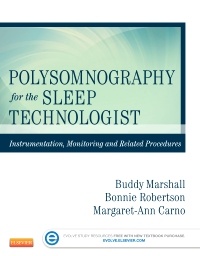Description
Polysomnography for the Sleep Technologist
Instrumentation, Monitoring, and Related Procedures
Authors: Robertson Bonnie, Marshall Buddy, Carno Margaret-Ann
Language: English
Subject for Polysomnography for the Sleep Technologist:
112.57 €
In Print (Delivery period: 14 days).
Add to cart416 p. · 21.4x27.6 cm · Paperback
Description
/li>Contents
/li>
The only sleep technology text written by experienced polysomnography educators, Polysomnography for the Sleep Technologist: Instrumentation, Monitoring, and Related Procedures covers the procedural knowledge you need to understand sleep studies. A sequential learning model systematically covers electronics, instrumentation, recording parameters, data acquisition, ancillary equipment, troubleshooting, recording quality, infection control, basic positive pressure therapy, and cardiopulmonary monitoring and intervention essential to polysomnography.
- In-depth discussions of polysomnographic technology
Chapter 1: Overview of Sleep Medicine, Sleep Physiology, and Polysomnographic Technology
Chapter 2: Classification of Sleep Disorders
Chapter 3: Electronics and Electricity
Chapter 4: Frequency, Voltage, and Morphology of Signals
Chapter 6: The Recording of Physiological Parameters and Electrical Safety
Chapter 7: Data Acquisition Systems
Chapter 8: Sensors, Transducers, and Ancillary Equipment
Chapter 9: The Polysomnogram: Pre-Study Procedures, Monitoring activities, and Post Study Scoring and Interpretation
Chapter 10: Recognizing, Evaluating, and Minimizing Artifacts During A Polysomnographic Recording
Chapter 11: The Cardiopulmonary System: Essentials for the Polysomnographic Technologist
Chapter 12: Non-Invasive Monitoring of Gas Exchange During Polysomnography
Chapter 13: Diagnosis, Treatment, and Outcome Management of Sleep-Disordered Breathing
Chapter 14: Infection Control and Emergent Response in the Sleep Center
Appendix I - Fundamental Math Concepts
Appendix II - Common Report Parameters and Recommended Settings
Appendix III - Measurements and Conversions
Glossary
These books may interest you

Sleep Medicine Pearls 70.66 €



